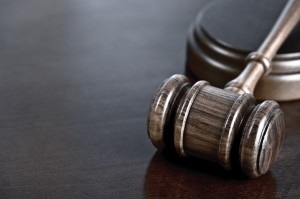Preview: The Freddie Gray Trials

UPDATE (December 16, 2015 6:00 pm EST): In the first of the six Freddie Gray trials, Judge Williams declared a mistrial in the case against Baltimore Police Officer William Porter. The jury was unable to reach a verdict on any of the four charges against Officer Porter, which include manslaughter, second-degree assault, reckless endangerment, and misconduct in office.
It is unclear how the mistrial will impact the dates of the other five trials, which are scheduled for early next year. The cases will be tried separately and consecutively. On Thursday there will be an administrative hearing to determine the new court date. There is a gag order in place on all parties in the case until all six of the Freddie Gray trials are complete.
Original Article (November 19, 2015):
In light of the six upcoming trials for the death of Freddie Gray that are set to begin on November 30, 2015, it is important to recognize the serious constitutional issues that arise in such public cases. Some major questions that stem from these upcoming trials are whether the outcome of each of the officer’s cases will affect the next case, and whether this constitutes a sixth amendment violation when it comes to the impartiality of the jury.
Below, we provide an overview of the case and some of the most salient details and legal issues that are likely to affect the shape of these trials and the ensuing legal ramifications.
Case Background
On April 12, 2015, Freddie Gray’s interaction with police began after he made contact with four bike-mounted police officers. When the officers approached him, he fled. When the officers apprehended him, they found a knife in his pants pocket and arrested him, reportedly “without force or incident.” After arresting Gray, the police requested a van to take him to the police station.
TIMELINE
- After the police request a van, Gray asks for an inhaler.
- Four minutes later, the driver determines that Gray is acting out in the back. They stop the van so that the paperwork can be completed, place Gray in leg irons, and place him back in the van.
- About 10 minutes later, a van driver requests additional help to check on Gray in the back. At this time, there is some communication with Gray.
- Five minutes later, they arrive at the police station where Gray is in distress, at which point the medics are called.
- When the medics arrive, they provide patient care then take him to the Maryland Shock Trauma Center. He is operated on for a fractured neck vertebra and crushed voice box.
- Grays enters into a coma and later passes away.
Officer Goodson was in charge of driving the van.
Sergeant White, the second-highest ranking officer involved in the Gray trial, is the officer responsible for conducting an investigation regarding complaints received following Gray’s arrest.
Officer Porter met the police van carrying Gray and helped the driver check on Gray.
Lieutenant Rice, Officer Nero, and Officer Miller have also been charged with various crimes relating to Gray’s death.
Penalties if Convicted
Each of the six officers has entered a plea of “not guilty.” If the prosecution is able to prove beyond a reasonable doubt that the officers are guilty then they could face the following sentences:
- Goodson has been charged with second-degree depraved-heart murder, which is a less severe charge than first degree murder. If convicted, he will face up to 30 years in prison.
- Officer Porter, Sergeant White, and Lieutenant Rice have been charged with manslaughter. The government must prove that the officers acted in a grossly negligent manner and that this grossly negligent conduct caused the death of the victim. If convicted, they can face up to 10 years in prison and a $500 fine.
- Officers Nero and Miller are facing lesser charges, including second-degree assault. If convicted, they could face up to 10 years in prison.
Strength of Evidence
The prosecution has worked to compile evidence that they can use to convict the six officers charged. As of June 30, 2015 the prosecution handed over 52 gigabytes of digital files to the defense. This evidence consists of the officers’ emails, 44 surveillance videos, and more than a dozen civilian statements.
Witness statements have been compiled from those who have suggested that they saw the officers rocking the van, beating the doors, and yelling. Other witnesses claim to have been with Gray on the day he was injured. These include the as-yet unnamed witness who fled with Gray before he was arrested, and Donta Allen, who was in the back of the van with Gray at the last stop prior to arriving at the police station where Gray was found unresponsive.
On August 31, the prosecutors provided the defense with additional information, including the “Western District Areas of Concern/Operational Plan,” which encouraged officers to conduct stop and frisks in the area where Gray was arrested because it was considered violent. According to the Baltimore Sun, the new evidence also included a statement from a police officer who recounted a previous chase, in which Gray allegedly discarded heroine. This information will likely be irrelevant at trial unless it can be demonstrated that the officers charged knew of Gray’s prior criminal activity and can convince the court that it is in some way relevant to how they reacted in this case.
The presiding judge, the Honorable Barry Williams, found recently that the statements given by Baltimore Police Officers Sgt. Alicia White and Officer William Porter will be admissible during their trials. The admissibility of their statements begs the question of whether the media’s role has created a sentiment surrounding this tragic case that has allowed the officers to be deprived of their constitutional rights.
Specifically, this evidence includes Officer Porter’s testimony, when he told White that Gray was in need of medical attention, as well as Sergeant White and Officer Porter’s statements concerning Freddie Gray’s transport to the police station. During the interview, Sgt. White testified that she knew that Gray needed medical attention, which could help support the prosecution’s argument that there was wanton or reckless disregard for human life.
Although, the $6.4 million settlement of the civil claims filed by the Gray family cannot be used as evidence by the prosecution, the selected jury may have a hard time separating their knowledge of this settlement from the case. To some, this settlement emphasizes the city’s acknowledgement of some level of liability in Gray’s death. During voir dire, an aggressive defense attorney will ask the necessary questions to determine whether the settlement will influence the potential jury members’ view of the officers’ fault. Even if the defense is able to weed out those jurors who do not understand that there is a lower standard that the plaintiffs must meet in a civil case, Judge Barry Williams will need to tailor his jury instructions to help ensure that the jurors understand the legal rules that they must follow when deciding a case.
What We Can Expect
A great deal can happen between now and the conclusion of the trials. For instance, Porter may break the police officer’s code of silence and enter a plea deal, which would affect the future of each subsequent case. However, there is already a great deal of media coverage surrounding the case, which has arguably influenced prospective jurors even before a single piece of official evidence has been presented. The facts presented so far, as well as the media coverage of Gray’s death, have created an understandable feeling that the police were wrong in this instance. Thus, the officers’ lawyers will need to prepare a strong defense to create doubt in the minds of the jury.
This being said, the United States legal system is based on the idea that a person is innocent until proven guilty. The judge, legal counsel, and media must work to ensure that the officers’ constitutional rights are preserved.
Points the Defense Might Raise
Based on the information that is available about this case, the defense is likely to raise certain points, including:
- The offense took place in a high crime area (specifically, a high drug crime area), where the officers had to constantly be on alert.
- Gray possessed a weapon that the officers claim they believed was illegal. Even though that weapon was only demonstrated to be illegal after the fact, the officers’ perception had a great deal to do with how they interacted with Gray, at least initially.
- Gray ran from the police. This flight is often viewed as consciousness of guilt by the police. When they spotted Gray on the street, they reportedly did not know whether he had a criminal record or if he was violent, but they were certain that he fled the scene.
- The policy on restraining Gray in the back of the vehicle was only a few days old at the time of the incident. This could mean that officers had yet to receive adequate training on how to safely implement that policy. An alleged violation of this policy allowed for the family’s settlement with the city. However, it did not necessarily mean that the officers had criminal intent.
- While White may have known that Gray needed medical attention, she was not necessarily aware of the severity of the injury. In order to determine whether she was negligent or demonstrated criminal intent, it will be necessary for the court to ascertain whether or not (and to what extent) she was trained to identify the need for medical attention.
Conclusions
In Baltimore, perhaps more than in any other city on the East Coast, relationships between law enforcement
and residents are uneasy on a good day. Combine this with the recent rash of widely-covered instances of police brutality across the country, and you have a situation where heightened tensions can result in mistakes and judgment errors on the part of both law enforcement and the people whom they are tasked with protecting.
There is no arguing that the death of a young man in police custody is a tragedy, and that has already been acknowledged by the City of Baltimore, as evidenced by the settlement between Gray’s family and the city. However, if justice is to truly be served, it is necessary to collect all of the evidence and provide the officers with the due process and fair consideration they deserve as U.S. citizens.
provide the officers with the due process and fair consideration they deserve as U.S. citizens.
Whatever the outcome, a fair trial is the only way to avoid compounding a tragedy with an injustice. If undertaken in good faith and handled diligently, these trials may be an opportunity for Baltimore to rise above the unflattering depictions rendered by movies and television shows like The Wire and present instead an example of how the U.S. criminal justice system is designed to work.
Kush Arora leads our D.C.-based law firm’s Maryland criminal defense practice group.
